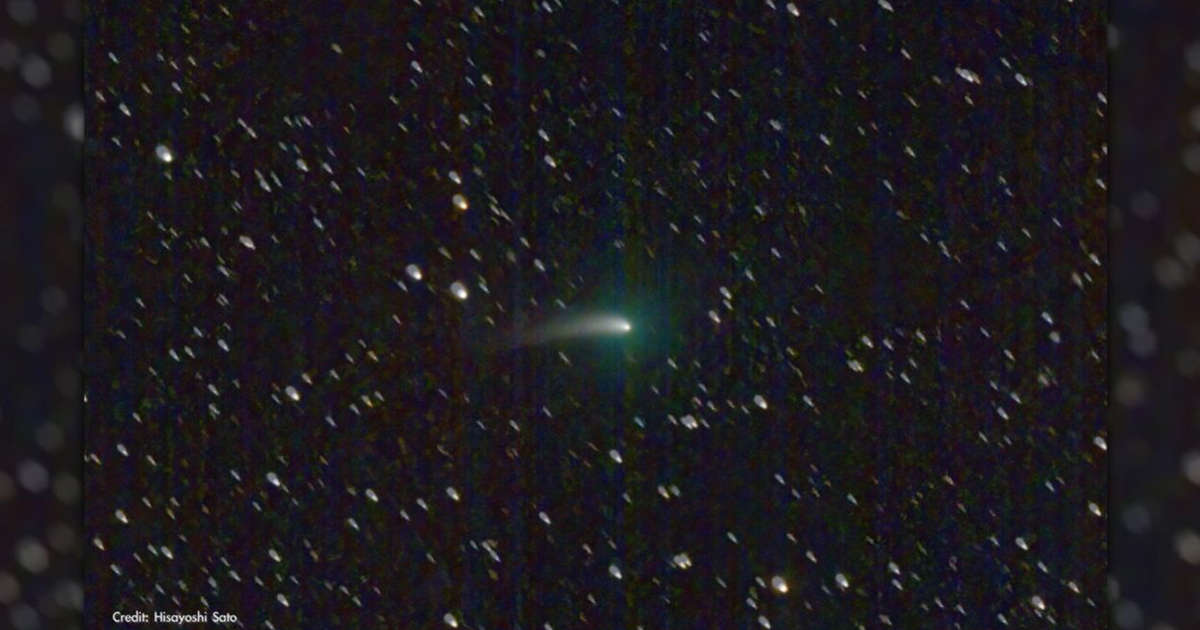[ad_1]
© Hisayoshi Sato via NASA/JPL-Caltech
An image of the Comet C/2022 E3 (ZTF) taken by astrophotographer Hisayoshi Sato as seen in a still image from a NASA video.
At the start of 2023 Earth will be visited by a newly discovered comet that may just be bright enough to be spotted with the naked eye.
The comet, named C/2022 E3 (ZTF), is currently passing through the inner solar system. It will make its closest approach to the sun, or perihelion, on Jan. 12, and will then whip past Earth making its closest passage of our planet, its perigee, between Feb. 1 and Feb. 2.
If the comet continues to brighten as it currently is, it could be visible in dark skies with the naked eye. This is difficult to predict for comets, but even if C/2022 E3 (ZTF) does fade it should still be visible with binoculars or a telescope for a number of days around its close approach.
Related: The 12 best night sky events to see in 2023
UP NEXT
According to NASA, observers in the Northern Hemisphere will be able to find the comet in the morning sky, as it moves in the direction of the northwest during January. C/2022 E3 (ZTF) will become visible for observers in the Southern Hemisphere in early February 2023.
Observers should look for C/2022 E3 (ZTF) when the moon is dim in the sky, with the new moon on Jan. 21 offering such an opportunity, weather permitting. According to the website Starlust, the comet will be in the Camelopardalis constellation during its close approach.
If you’re hoping to observe C/2022 E3 (ZTF), our guides for the best telescopes and best binoculars are a great place to start. If you’re looking to snap photos of the night sky, check out our guide on how to photograph the moon, as well our best cameras for astrophotography and best lenses for astrophotography.
According to NASA Jet Propulsion Laboratory (JPL), the comet has a period of around 50,000 years. This means that prior to it coming to within around 100 million miles (160 million kilometers) of the sun on Jan. 12 and 26 million miles (42 million kilometers) of Earth on Feb. 2, the last time it came so close was during the Upper Paleolithic period on Earth.
That means the last humans that could have spotted C/2022 E3 (ZTF) were early homo sapiens alive during the last glacial period or “ice age.” So, too, could some say of the last Neanderthals, as that species became extinct around 10,000 years after the last perihelion of C/2022 E3 (ZTF).
Of course, the Neanderthals and early humans wouldn’t have known what C/2022 E3 (ZTF) was, and the comet was identified much more recently than the last ice age. The comet was spotted by the wide-field survey camera at the Zwicky Transient Facility in early March 2022.
Initially appearing to be an asteroid, C/2022 E3 (ZTF) which was inside the orbit of Jupiter at the time, soon began to brighten as comets do. At the time of its discovery, C/2022 E3 (ZTF) had a magnitude of 17.3, brightening to a magnitude 10 in November, and expected to eventually reach magnitude 6.
Current images of C/2022 E3 (ZTF) show its coma, a surrounding halo of gas and dust, glowing with a greenish hue and a long but faint cometary tail extending from its main body.
Editor’s Note: If you snap the comet C/2022 E3 (ZTF), and would like to share it with Space.com’s readers, send your photo(s), comments, and your name and location to [email protected].
Follow us on Twitter @Spacedotcom or on Facebook.
[ad_2]

